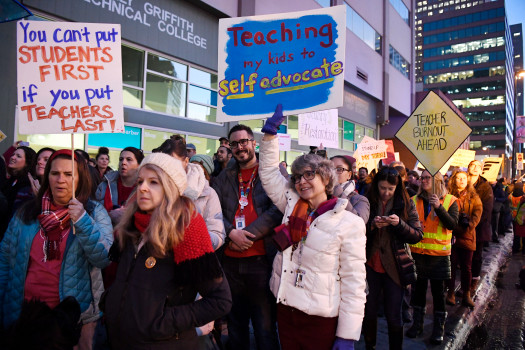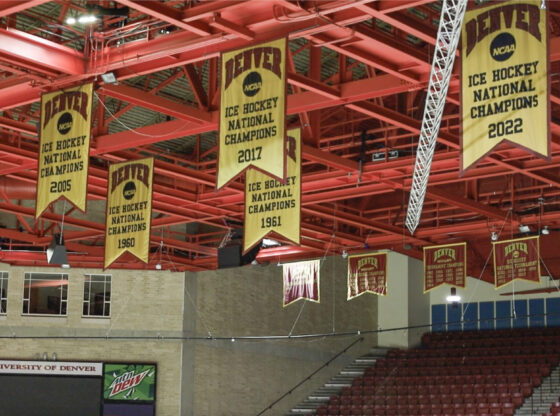While growing up in the Aurora Public School (APS) system, I saw first-hand what a lack of educational funding does for the classroom. For Spanish and social studies classes, students worked from old, worn and torn books; the science department often did not have enough materials for all students to participate in labs; teachers who were favored by students were constantly let go by administrators. All of these things impacted the classroom environment, in addition to the sense of school community and morale.
It was clear to my classmates and me that we needed funding, and it wasn’t just our school. Colorado spends roughly $7,662 per pupil per year, while the national average for public education is approximately $12,526 per pupil per year. As a student, this statistic scares me. Do Colorado lawmakers and voters not care about public education?
In the final months of my senior year of high school, I dressed in red and rallied with thousands of educators, parents and students at the Denver capitol building. Picket signs waved, thousands of voices chanted in unison and car horns sang support all in hopes that Colorado legislators and voters would recognize the need for more educational funding. Less than a year after the national teacher walkouts and rallies, I witnessed the Denver Public School (DPS) teachers strike, which included my high school theatre teacher, Ryan Hill.
“Teacher pay in general is lacking around the country, particularly in Colorado,” Hill explained. “We’re kind of always on the lower end in terms of teachers, especially after losing Amendment 73 in November.”
Last November, Colorado voters rejected Amendment 73, which would have increased income, corporate and property taxes to raise money for Colorado’s public schools. Many teachers were in support of Amendment 73, and it was a disappointment to see the amendment fail. APS passed a ballot measure that would directly impact the classroom. Additionally, the ballot measure would help retain high quality teachers, which is something DPS has struggled with for a while because of their pay scale.
It is Ryan Hill’s first year at DPS, and he has felt welcomed and appreciated by the district; however, he thinks the pay scale needs to be reevaluated to better benefit teachers and students.
“There’s a lot more support for theatre arts in DPS as compared to my old district, but the very top-heavy approach that Denver has always had in terms of the crazy number of administrative positions in the central office really takes its toll on the classroom. DPS in particular has a pay scale that’s very unpredictable and not transparent when compared to many other districts in Colorado.”
The pay scale was one of the main points of the strike, which is why the Denver Classroom Teachers Association pushed to lower incentives for working in high-poverty and high-priority schools to free up money for overall teacher pay. There was also concern over the district allocating too much money for administrative positions. Meanwhile, DPS sees bonuses as key to boosting the academic performance of poor and minority students. The non-traditional pay system that Denver has adopted leads to high turnover, which ultimately hurts students.
Anna Gebhardt, friend and previous colleague of Hill and a DU alum, mentioned her support for the DPS strike: “It is not easy to strike, especially without pay, and it isn’t easy for [teachers] to be out of their classrooms, but they are doing it because their requests have been ignored and they want their voices heard.”
After 15 months of negotiations and being put on hold due to the state intervening, the Denver teacher strike began Monday, Feb. 11. Teachers showed up to their schools before students entered classes, and they picketed outside their school buildings in below freezing temperatures. Tuesday, teachers gathered outside the central Denver Public Library as negotiations took place inside. However, an agreement was not made that afternoon, and the strike continued with 58 percent of teachers not reporting for work on Wednesday. Thursday marked the end of the strike as a tentative agreement was made, and teachers were back in the classroom Friday morning.
The agreement helps ensure educators have a transparent salary schedule that is less dependent on unpredictable bonuses. It includes a 20-step salary schedule, clear increases of between seven percent and 11 percent in base salary and cost of living increases. For the agreement to take effect, it must be ratified by a majority of members of the teachers association. Colorado Public Radio reports that the union’s offer agreed to $3,000 retention bonus for high priority schools—so long as a study could prove their effectiveness—$2,000 incentive for hard to fill and hard to staff schools and a salary structure that starts at $45,800.
While this tentative agreement is great for DPS, its teachers and its students, Colorado has a lot more to do for other districts. Rural school districts, such as Kit Carson, aren’t receiving adequate government funding, and their educators and administrators have to pick up that slack by teaching multiple subjects and playing multiple roles. The implementation of arts education programs and curriculum continues to face controversy even though it has seen significant achievements. While teachers and districts have guides to offer mental health support for students, schools still don’t have the funding for counselors and other mental health professionals.
Public education is the foundation of students’ lives, and it’s critical that we are properly funding school districts, teachers and classrooms. As a future educator, I am happy to see DPS reach an agreement, and I am even more proud that teachers were able to practice their right to strike even though it was hard to leave their students. Colorado’s education system is not something that can be fixed overnight, or even within a couple of years: we must be adamant about changing the system to better support our students and their teachers, and the DPS strike was a step in the right direction.











